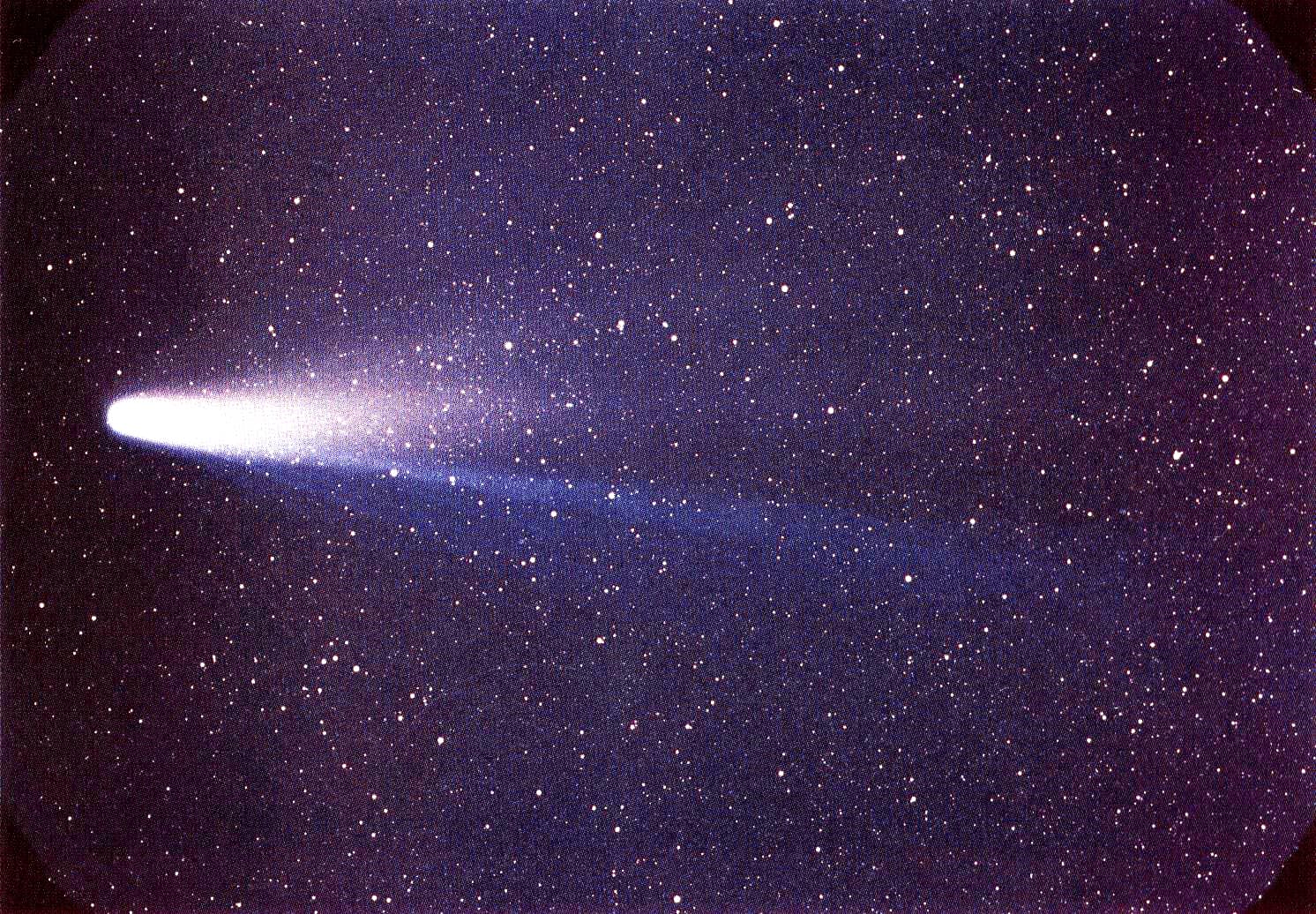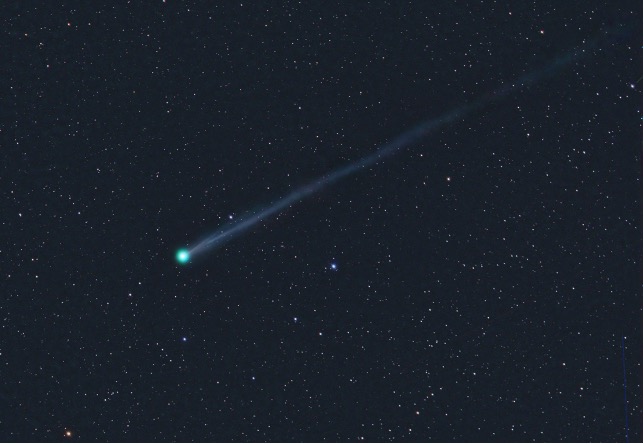Picture gazing at the sky and spotting a star with a glowing tail streaking across the darkness, a spectacle that has captivated humanity for centuries. Comets, those cosmic travelers made of ice, dust, and rock, are known for their rare and dazzling appearances, often visible to the naked eye. In 2025, C/2024 G3 (ATLAS) lit up the skies in January, while others, like C/2025 F2 (SWAN), are sparking curiosity. But which are the most famous comets in history? And how can you observe them without a telescope? At The Astronomy Insider, we explore iconic comets, their stories, and practical tips for hunting these celestial wonders in the night sky. Get ready for a cosmic adventure!
What is a Comet?
Comets are celestial bodies composed of ice, dust, and rock, originating from distant regions of the Solar System, such as the Oort Cloud or Kuiper Belt. As they approach the Sun, heat vaporizes their materials, forming a coma (a gaseous cloud) and often a radiant tail that can stretch millions of kilometers. This tail, visible when the comet is near Earth, makes them so striking.
Comets are classified as periodic (with regular orbits, like Halley’s Comet) or non-periodic (appearing once and possibly not returning for millennia). Their naked-eye visibility depends on apparent magnitude, a measure of brightness: comets with a magnitude below +6 are typically visible without equipment. In 2025, the proximity of comets like C/2024 G3 (ATLAS) drove searches for “visible comets” and “how to observe comets.”
The Most Famous Comets in History
Some comets have left their mark on history due to their beauty and cultural impact. Here are the most iconic ones visible to the naked eye:
- Halley’s Comet (1P/Halley)
- Fame: The most famous comet, observed since antiquity, with Chinese records dating back to 240 BC. It’s the only periodic comet visible to the naked eye that returns within a human lifetime (~76 years).
- Last Appearance: 1986, reaching magnitude +2 in low-light-pollution areas, 90 million km from Earth.
- Next Appearance: 2061, already sparking searches for “Halley’s Comet 2061” in 2025.
- Fun Fact: Inspired awe and fear, linked to events like the Norman Conquest of 1066.
- Comet Hale-Bopp (C/1995 O1)
- Fame: One of the brightest comets of the 20th century, visible to the naked eye for 18 months between 1996 and 1997, with a magnitude near 0.
- Details: Discovered by amateur astronomers, it shone brightly due to its large nucleus (40-80 km).
- Impact: Made global headlines and sparked conspiracies, but also inspired mass observations.
- Current Searches: “Hale-Bopp” remains popular among enthusiasts reminiscing about its passage.
- Comet Hyakutake (C/1996 B2)
- Fame: Stunned in 1996 by passing just 15 million km from Earth, with magnitude +0 and a tail visible for weeks.
- Details: Its proximity made it one of the brightest comets in recent history.
- Fun Fact: Studied by probes, it revealed organic compounds in its composition.
- Comet McNaught (C/2006 P1)
- Fame: Known as the “Great Comet of 2007,” it reached magnitude -5, brighter than Venus, visible in the southern hemisphere.
- Details: Its tail, visible even in urban areas, was a spectacle for countries like Australia and Brazil.
- Current Searches: “Comet McNaught” is searched by those exploring historic comets.
- Comet C/2024 G3 (ATLAS)
- Fame in 2025: Discovered in 2024, it reached magnitude +2 in January 2025, visible to the naked eye in the northern hemisphere and partially in the south.
- Details: Passed 0.2 astronomical units (AU) from Earth, generating buzz on social media and searches for “comet ATLAS 2025.”
- Impact: Inspired global viewing events, with photos shared on Twitter/X.
Want to learn more about cosmic phenomena? Read “Wandering Black Holes: What is AT2024tvd and Tidal Disruption Events?” on our blog!
Comets Visible in 2025
Beyond C/2024 G3 (ATLAS), another comet is in the spotlight:
- C/2025 F2 (SWAN): Expected to reach magnitude +4 in November 2025, visible to the naked eye in dark skies, especially in the northern hemisphere. Searches for “comet SWAN 2025” are rising, as noted in Twitter/X posts.
While not all 2025 comets are as bright as Halley or Hale-Bopp, they offer unique viewing opportunities. The next major chance may involve lingering interest in Comet Tsuchinshan-ATLAS (C/2023 A3), which shone in 2024.
How to Observe Comets with the Naked Eye
Observing comets with the naked eye is accessible but requires preparation. Here are practical tips:
- Choose a Dark Location: Escape urban light pollution. Rural sites or remote parks are ideal. Use light pollution maps, like those at lightpollutionmap.info.
- Check the Magnitude: Comets with magnitudes below +6 are naked-eye visible. Find predictions on sites like heavens-above.com or apps like Stellarium.
- Use Binoculars (Optional): For fainter comets (e.g., magnitude +5), 10x50 binoculars enhance the tail’s visibility.
- Track the Calendar: C/2025 F2 (SWAN) will be visible in November 2025, especially after sunset. Stay updated via the National Observatory (@observatorio.on) on Twitter/X.
- Be Patient: Comets may take days to peak in brightness. Observe over multiple nights for the best view.
Why Comets Captivate Us
Comets are more than beautiful; they tell the story of the Solar System:
- Cosmic Origins: Formed 4.6 billion years ago, they contain pristine materials revealing how planets formed.
- Cultural Impact: In antiquity, they were seen as omens. Today, they inspire science and art.
- Modern Science: Probes like Rosetta, which studied Comet 67P in 2014, suggest comets may carry organic molecules, hinting at their role in life’s origins.
In 2025, comets like C/2024 G3 (ATLAS) united communities in viewing events, showcasing their power to connect people to the cosmos.
Connect with the Sky in 2025
Comets remind us that the universe is in constant motion. You can connect with these celestial wonders:
- Track Celestial Events: Beyond C/2025 F2 (SWAN), the Venus-Jupiter conjunction on August 12, 2025, and the Perseid meteor shower (peaking August 12-13) are must-sees.
- Use Apps: Stellarium or Sky Tonight help locate comets and planets. In May 2025, Jupiter is bright, great for practice.
- Join the Community: Visit planetariums, especially during the planetarium centennial on May 7, 2025, to learn more.
- Share Your Experience: Spotted a comet or eager to try? Leave a comment and share with friends at The Astronomy Insider! Subscribe for more cosmic adventures.
Sources
- NASA Science. “Comets: Visitors from Deep Space.” Accessed May 22, 2025. https://science.nasa.gov/solar-system/comets/
- ESA. “Rosetta Mission: Comet 67P.” 2023. https://www.esa.int/Science_Exploration/Space_Science/Rosetta
- “Cometa C/2024 G3 (ATLAS): Um Espetáculo no Céu de 2025.” olhardigital.com.br, January 15, 2025.
- Post on X by@observatorio.on, January 10, 2025.
- Post on X by@NASA, May 20, 2025.







No comments:
Post a Comment